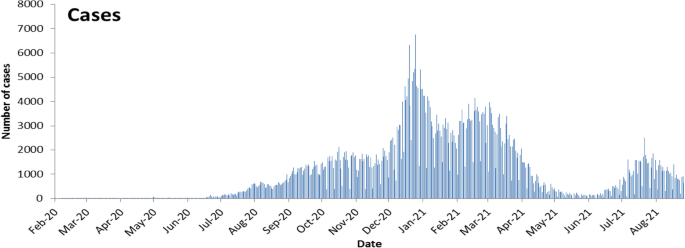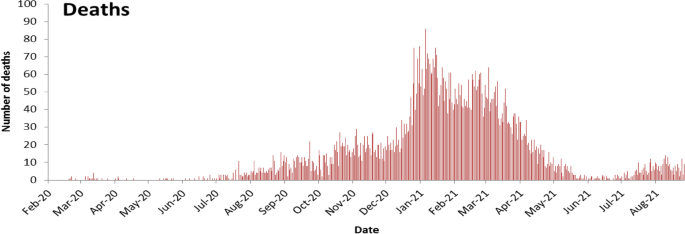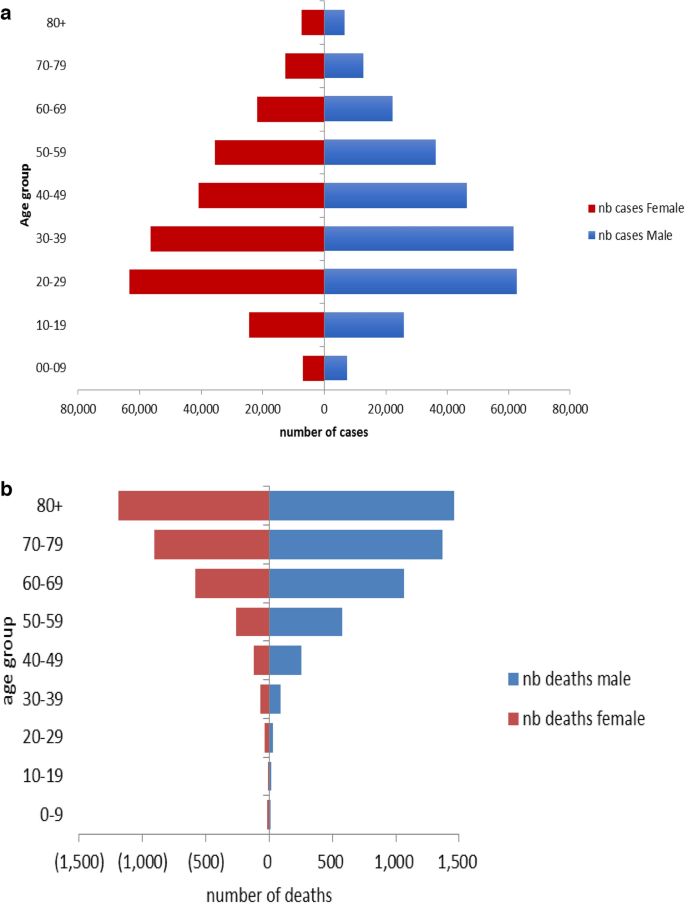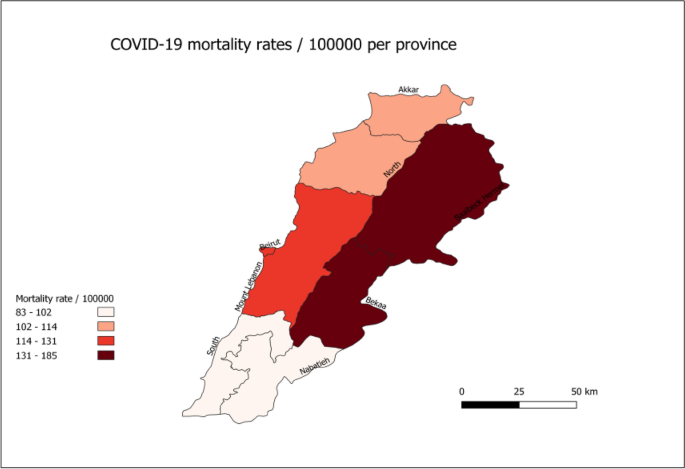COVID-19 mortality surveillance in Lebanon | Scientific Reports

Temporal distribution of COVID-19 confirmed and death cases
Between February 21, 2020 and September 15, 2021, a total of 614,069 confirmed COVID-19 cases and 8163 COVID-19 related deaths were reported to the ESU. Figure 1 illustrates the epidemic curve of laboratory confirmed cases in Lebanon starting February 21, 2020 and up to September 15, 2021.
The first death was reported on March 10, 2020. The death curve progressed in various phases (Fig. 2):
-
Phase A from March to mid-July 2020: few deaths per day with a daily average of 0.3, ranging from 0 to 4, and representing 1% of all deaths. This phase reflects the introduction of the virus and detection of several clusters and the initiation of early lockdown measures. In the 21st February, the first COVID-19 case was confirmed among travelers. Early cases were isolated in designated hospital with contact tracing. On March 15, 2020, the emergency status was declared with school and business closure and travel restriction.
-
Phase B from mid-July 2020 to end December 2020: with progressive increase of daily count, a daily average of 10.6 deaths, ranging from 0 to 30, and representing 22% of all deaths. This phase reflects the progression into community transmission following airport opening in July 2020. During that phase, the port of Beirut blast on August 4, 2020 contributed to the increase of the daily number of positive COVID-19 cases and later deaths. The explosion damaged many nearby hospitals, overcrowded healthcare facilities with patients.
-
Phase C from January to mid-May 2021: corresponding to the big wave, with a daily average of 42.9, ranging from 10 to 98 (on February 4, 2021), and representing 70% of all deaths. This phase reflects the huge wave that has followed end 2020 social events, and implementation of the second general lockdown. The wave lasted from January to mid-May 2021.
-
Phase D from mid-May to end July 2021: inter-wave period with a daily average of 3.7, ranging from 1 to 11, and representing 5% of all deaths.
-
Phase E starting August 2021: new wave with a daily average of 6.8 deaths, ranging from 3 to 15, and representing 2% of all deaths.
Distribution by age, gender and nationality
Among the total 614,069 confirmed COVID-19 cases included in our study, 21.1% occurred in the ages between 20 and 29 years (Table 1). There were a higher proportion of male cases compared to females overall (1.06:1) and also within all age groups (Fig. 3a). The age pyramid of the deaths shows the predominance of older people and in particular among males (Fig. 3b). The distribution of deaths by age groups was as follows: 32.9% for 80 years and over, 28.2% for 70–79 years, 20.4% for 60–69 years, 10.4% for 50–59 years, 4.7% for 40–49 years, 2.0% for 30–39 years, 0.8% for 20–29 years, 0.3% for each 10–19 years and 0–9 years. The average age of the deaths was 72.4 years with a 95% Confidence Interval (CI) between 44 and 77. Regarding gender, 60.4% of deaths were males. The nationality distribution of the COVID-19 related deaths was as follows: 93.9% Lebanese, 2.9% Palestinian, 2.7% Syrian, and 0.2% Iraqi, 0.1% from Egyptian, 0.1% Bangladeshi, and 0.1% Ethiopian.
Deaths by place: province of residence
Mortality rates showed variations across provinces. The highest cumulative mortality rate was reported in Bekaa (184.7/100,000), followed by Baalbeck-Hermel (136.8/100,000), Beirut (129.3/100,000), Mount Lebanon (121.2/100,000), North (106.6/100,000), Akkar (102.9/100,000), Nabatieh (100.2/100,000), and South (82.6/100,000) (Fig. 4).
Mortality rates and case fatality ratios
The cumulative mortality rate was 119.6/100,000, 95% CI 117–122. Deaths related to COVID-19 varied considerably by age with the highest cumulative mortality rates among the elder population aged 80 years or above (2524.5/100,000), and the lowest one among children aged 0–9 years old (2.2/100,000). Regarding gender, the mortality rate was found to be higher among males (143.5/100,000) than females (95.3/100,000) (p-value < 0.0001) (Table 1).
The overall case fatality ratio (CFR) in the Lebanese population was found to be 1.3%. When data were stratified by age group, the CFRs appear similar for age groups 0 to 49 years, but ratios increased significantly starting age of 50 years and in particular for those aged 70–79 years old (8.5%) and those aged 80 years and above (14.0%) (p-value < 0.0001). Moreover, case fatality ratios differed by gender with a higher ratio for males compared to females (1.6% for males versus 1.1% for females (p-value < 0.0001) (Table 1).
Comorbidities
Of the total deaths, 82.2% of the deaths had at least one comorbidity (Table 2). Cardiovascular disease was the most commonly reported comorbidity among confirmed COVID-19 cases both overall (59.1%) and as a single comorbidity (28.3%) followed by diabetes (37.2%), kidney diseases including dialysis (11%), cancer (6.7%), and lung diseases (6.3%). Diabetes and Cancer were reported as single comorbidity among 6.1% and 3% of the deaths respectively. The overall CFR was 4.7% for patients with comorbidities. The CFR was 30.9% for kidney diseases, 20.2% for cancer, 20.2% for lung diseases, 18.1% for liver diseases, 14.0% for diabetes, 12.2% for cardiovascular diseases, 8.5% for hematological diseases, 8.2% for overweight, 5.1% for immunodeficiency, 3.4% for asthma, 2.4% for post-partum, and 1.1% for pregnancy (Table 2).
Case management
As of September 15, 2021, among the 8163 deaths, 7135 (87.4%) were admitted to hospitals, 1963 (24.0%) admitted to intensive care unit (ICU), and 1021 (12.5%) required mechanical ventilation. Of all deaths, 84% occurred at healthcare facilities and 16% at home. The CFR was 22.7% for COVID-19 patients who were admitted to hospitals, 55.1% in case of ICU admission, and 68.3% in case of mechanical ventilation (Table 2).
Vaccination status
The MOPH launched the national vaccination campaign against COVID-19 on February 15, 2021. Of the total 3905 COVID-19 related deaths that occurred between February 15, 2021 and September 15, 2021, 1.5% of the death cases were fully vaccinated and 0.8% of the death cases were partially vaccinated.






